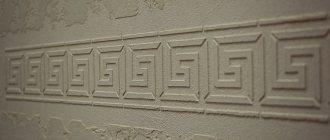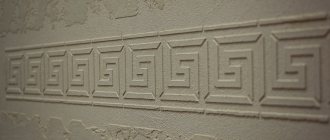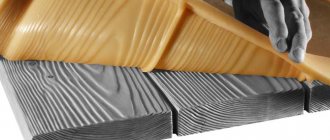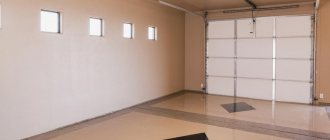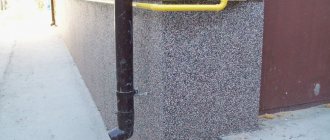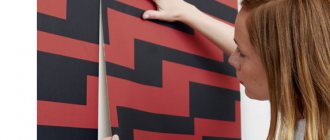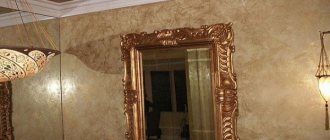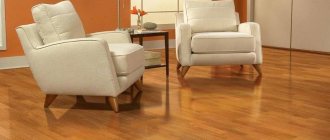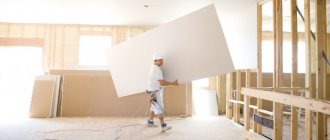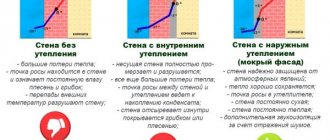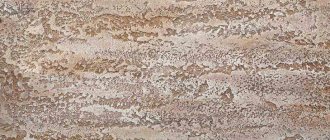Wall decoration with decorative plaster has gained popularity over the past 5 years. At the same time, applying decorative plaster is considered a complex process that cannot be done independently, and hiring a professional is expensive because the cost varies from 700 to 1,500 rubles. for 1m2. In fact, this is not so, all the work can be done without hiring hired specialists, and the result obtained will be no worse.
By choosing a decorative coating as a finishing material, you will give your home a unique design that will compare favorably with traditional renovation methods. Remember that, despite the beauty, this finish has its pros and cons.
The advantages include:
- Easy to clean;
- The design will be very impressive and 100% individual;
- The coating is durable;
- Requires minimal care;
- Not afraid of strong temperature changes;
- Some types of structural mortars act as an additional layer of insulation;
- Most materials are environmentally friendly;
- Some types of finishing will help hide the imperfections of the walls.
The disadvantages of using are:
- High cost (applies only to some mixtures);
- Some compositions require good preliminary preparation of the walls;
- Complexity of application compared to traditional repair methods;
- Lengthy and labor-intensive replacement process.
If these disadvantages are not critical, such repairs will be an excellent choice for both an apartment and a private house.
If you have no experience working with decorative materials yourself, it is recommended to practice beforehand. This can be done on pieces of drywall or plywood.
Types and methods of applying decorative plaster with your own hands.
Today, many types of decorative plaster are produced for wall decoration. Each of them has its own special options for applying plaster. But the surface preparation technology, the main part of the tool and the painting technology are the same.
To tell the reader how the technique of applying decorative coatings differs, let’s look at their main varieties.
Textured.
These decorative compositions include mixtures that give a unique relief on the wall when using a special tool (for example, structural rollers), the relief can also be obtained using special installation techniques (for example, decorative plaster world map). The movements of the master's hand in combination with the use of a special tool will create the desired patterns.
Structural.
For structural mixtures it is not necessary to use a special tool or special technique. An extraordinary relief is obtained due to the fillers included in the composition. Granite and marble chips, mineral inclusions, fibers of various fabrics and more are used as filler. Using a spatula and trowel, apply one layer to the surface, after the first layer has dried, use the trowel again to create a pattern. There are also marble plasters that create a stone shell of walls entirely consisting of particles of this noble stone.
Venetian.
This type of decorative plaster will give the house the real luxury of a Roman mansion. This wall covering imitates natural stone, most often marble, granite, malachite, etc. Before applying the composition, be sure to practice on sheets of drywall. The application process will be described separately because... is complex and a brief description will not be helpful.
Bas-relief
In the article, by bas-relief we will understand all types of sculptural images made using gypsum or other types of plaster and receding from the plane of the base to a short distance. Such work is carried out with subsequent decoration. If you feel the strength and talent to choose a bas-relief as a decoration, the efforts spent will be returned a hundredfold.
Choosing one of the listed types is difficult, but necessary, because the future method of application will depend on this choice.
Application techniques
It is impossible to talk about every method of applying decorative plaster - there are so many different details and nuances. The simplest case is with textured plasters. They are simply applied with a spatula. The whole difference is in the direction of movement of the spatula, in the depth of the beards that leave inclusions, and in color. But this is in the basic version. No one is stopping you from experimenting with these compounds. Another thing is that on structural ones the effect of the same actions is more impressive - more flexible compositions.
What can be used to create a decorative effect
Application of decorative plaster is possible with many tools and ordinary household materials and devices made from them:
- Metal trowels and graters. They are used not only for applying the composition in an even layer, but also for forming geometrically chaotic patterns on it.
One example of using a grater - Construction floats made of plastic, foam. They are used to level out and smooth out the newly formed overly protruding relief.
- Fine grit sandpaper. Also for leveling the relief, but on already dried material. When compared with the previous method, the effects are different.
- Foam sponges. They are multifunctional. They can: Create surfaces of various types. Waves, needles (if you apply the putty to the surface and tear it off sharply), some kind of balls or flowers (turn the sponge 180°), etc.
- Remove paint from protruding parts, making the texture clearer and more voluminous.
Sponge and paper will also work
- By spreading a thin soft polyethylene film on freshly applied decorative plaster, you can form a relief with your hands. It could be some kind of abstraction or something with some motives. When the relief is ready, the film is carefully removed and the relief is left to dry.
Different rollers - different surfaces
Rubber gloves and stiff bristled brushes
Principles of relief formation
Decorative plaster is attractive because it allows you to create a unique design - you can use your own imagination. To make this drawing look harmonious, you need to know some general rules. Good manufacturers have rules for working with it in the description of each composition. It describes the procedure, application methods, and techniques for forming decorative surfaces.
A simple method is rolling with a roller with a pattern molded on it.
Large companies (manufacturers or shopping centers) conduct master classes where anyone can try to work with a specific decorative plaster, which is also provided there, rather than experimenting “on the spot.” Therefore, before purchasing, be sure to read all the available material, watch videos, which are also often available, and in large quantities - there are really many methods of work. Describing in words is difficult and often incomprehensible. It's much easier to do everything in video format. We will try to briefly summarize the techniques.
- When working with structural plasters painted in the paste (the color is added to the composition), a thin base layer is first applied. It can be smooth, or maybe slightly textured - rolled with one of the rollers. This layer is allowed to dry (6-24 hours depending on the manufacturer). Then, using the same or clarified composition (an uncolored composition is added, obtaining a mass several tones lighter), one of the reliefs is formed. Further options: Immediately after formation, until the plaster has dried, the overly protruding parts are slightly smoothed with a stainless or plastic trowel.
- Wait until the layer dries. Sandpaper attached to a holder or a wooden block is used to clean off some part of the relief.
- The most difficult technique is to apply Venetian plaster. The layers are very thin, translucent, there are many of them and they are applied in different ways:
- An even, thin base coat is applied first. It dries up.
- The layer is left to dry for 4-5 hours.
- Take a large stainless spatula or grater and rub (iron) the surface. At the same time, the sharp edges are slightly erased, the surface becomes smooth in places, and velvety in appearance in others. The “marble effect” begins to appear.
- The next layer is almost the same, but you just need to level the surface as much as possible.
- The layer is left to dry for 1.5-2 hours.
- Smooth it with an even, burr-free spatula with rounded ends (so as not to accidentally damage it). At this stage, the surface acquires a glossy shine.
- The final stage is coating with decorative wax. This layer increases the moisture resistance of the coating, and the glossy shine becomes more pronounced.
Thin chaotic strokes are applied, which gradually fill the surface. In this case, a certain, not very pronounced relief is obtained - strokes of different thicknesses and different directions are obtained.
Preparing the wall surface.
Let us briefly dwell on this stage of work as preparing walls for decorative plaster. Beginning craftsmen often wonder whether it is necessary to level the surface to perfection?
Like wallpaper, decorative plaster can be applied to uneven walls, but with some restrictions. For example, coatings requiring gloss should be applied to perfectly flat areas. Otherwise, after glossing, all irregularities (depressions, protrusions, differences) will become visible. Most of the solutions do not require special preparation, and on the contrary, textured and structural ones will help hide minor imperfections.
If you do not have the desire or ability to level the walls to an ideal state, in any case, the main thing is to properly prepare the surface before application.
For any finish the algorithm will be the same:
- Remove old plaster (especially if it is peeling).
- Repair cracks and scratches;
- Perform a rough finish - just plaster with a cement-sand mixture until strong visible defects are eliminated;
- Cleaning and dust removal are mandatory;
- Application of deep penetration primer.
As you can see from the above, the process described above is not complicated, and anyone can do it.
Advantages of modern mixtures
Decorative plaster is a worthy alternative to wallpaper and paint. The material is distinguished not only by its attractive appearance, but also by its high performance characteristics. Mixtures for wall finishing include plasticizers and various fillers that improve the quality of the coating.
Advantages of the material:
- ease of application;
- no seams;
- masking the imperfections of the original coating;
- environmental Safety;
- durability and resistance to UV rays;
- external attractiveness;
- easy restoration;
- moisture resistance.
Creating original interiors was previously available only to wealthy people. Decorative types of plasters are inexpensive, cheaper than some types of wallpaper. Modern mixtures for wall finishing and the hands of a craftsman create an imitation of almost any surface for a reasonable price.
The material is available to the mass consumer. Today on the market there is a wide variety of types of finishing for any interior - from classicism to high-tech style. Applying decorative plaster to a wall is a creative and not complicated process. The main thing is to follow the technology and not forget about the sequence of all stages of finishing work.
What you need to apply decorative plaster yourself.
In addition to the mixture itself, plastering requires a tool, and it will differ from the standard one. Like the technology, the equipment will change depending on the type of wall covering chosen.
Ordinary spatulas will not work, firstly, they have sharp edges, and secondly, they metalize the surface.
Let's list the required tool:
- Spatulas for decorative plaster have rounded edges and are made of high-quality metal.
- Trowels. Often special trowels are even called Venetian.
- Sponges for creating textures.
- Brushes for creating custom designs
- Special structural rollers
- How to paint the plaster is up to you. You can paint by adding a regular color to the base mass, or you can paint the already applied layer; for this, a sponge or brush will be enough.
Special tools are not cheap, but you will need them.
Accessories:
- Cotton gloves;
- Respirator;
- Fabric to protect floors and walls from dust and construction debris;
- Buckets;
- Stepladder for working at height;
Materials and tools
With the help of decorative plaster, unique and original finishing coatings are created on the walls. To do this, you need to buy ready-made decorative mixtures or ordinary gypsum plasters and prepare the necessary tools.
Ready-to-use decorative materials can be found among the following brands: Ceresit, VGT, San Marco. Good dry mixes for plastering: Knauf Uniflot, Knauf Rotband, Ceresit ST127 and other analogues.
Find out how to make a decorative coating from ordinary putty in our article.
To apply the solution and create texture on the wall you will need:
- rectangular trowel;
- wide and narrow spatula;
- wide brush;
- rollers (fur and figured).
How to apply textured plaster.
Correctly applying decorative plaster to walls is not difficult, especially when it comes to textured mixtures. Let us remind you that textured or embossed mixtures are called mixtures whose pattern is created using special tools. To create an original relief, improvised materials are often used, such as: cellophane bags, wrapping paper, newspapers and much more.
Application steps:
- Preparation . Textured plasters are precisely those mixtures that do not require very careful leveling of the walls. It is enough to remove severe surface defects.
- Application. Using the textured mixture is very simple. As a rule, it is applied in a thicker layer compared to other types of coatings. Use a spatula and trowel to apply.
- Relief creation . Patterns are created with different tools.
Here are examples of such patterns obtained with different tools:
Canvas drawing - created with a hard brush, drawing first vertical and then horizontal lines, you will get a real artistic canvas.
Circular pattern - created by the same brush by rotating around an axis; waves or circles of different diameters also look good
Patterns with a roller – various patterns can be obtained using special structural rollers. You need to choose a roller with a pattern you like in the store and simply roll it along the wall. This way you can even get the texture of natural reptile skin.
Spraying is the simplest method. The first layer is applied evenly. The second step is to take a broom and dip it into the plaster, at this time you should have a stick in your other hand. By hitting a broom with a stick, we get a relief of various splashes on the wall. You can paint the first layer in any color, and spray it with another or even several colors.
- Leveling the formed coating. Often, after processing with a tool, parts of the relief that are too protruding remain; to remove such marks, use a trowel to smooth the slightly dried coating.
- Coloring. You can paint in one or two stages. You need to paint with a roller or sponge, this way the tops of the relief are made lighter, giving visual depth.
As you can see, do-it-yourself decorative plaster on walls is applied in just 5 simple steps.
Compliance with the correct sequence and accuracy in work guarantees a good result.
Creating a textured coating
You need to know not only how to apply decorative plaster, but also how to make a textured surface from it . The application method will depend on the effect you want to achieve. With gypsum putty it is easy to imitate leather and finishing stone and create a relief pattern. Finishing mixtures are best suited, but you can mix them with starting mixtures in equal proportions. The solution is mixed strictly according to the manufacturer's instructions.
To create a base, a thin layer of putty is applied to the primed surface. The thickness of the coating will be no more than five millimeters. The work starts from the bottom, the mortar is spread in long strokes along the wall. Having applied the composition to two square meters, you need to immediately proceed to applying the relief, otherwise it will no longer be possible to remove anything from the set mixture.
The simplest working tool can be called a wad of rag, which is wrapped in plastic film. The created tool is applied to the wall, after which you need to make a rotational movement with your hand to tear the film off the composition. You will get a spiral curl. These prints can be arranged in any order. The wall will be covered with patterns reminiscent of peonies or roses. After treating the entire surface, you need to wait a day.
Then the wall is covered with a layer of water-based or acrylic paint and left for three hours. Next, polishing is done with a metal spatula to smooth out strongly protruding peaks. Some of the paint is also removed, exposing the base light layer. The result is a vibrant floral pattern.
You can make wavy patterns of lines with your own fingers. You can leave ring-shaped marks with a round plastic washcloth; use a sponge with large holes to form a surface that will resemble shagreen leather . Sometimes reliefs are applied with a regular roller, which is first wrapped with a thick cord - the effect of bamboo stems is obtained.
Special stamps and roller attachments are required to create imitation reptile skin. A snake scale or crocodile skin pattern needs to be painted over twice after drying to highlight the depth of the pattern. The layers of paint will differ slightly in tone, the top layer is applied extremely carefully: you only need to paint over the protruding parts of the “scales”. You can apply glitter or gilding with a soft sponge.
How to apply structural decorative plaster to walls with your own hands.
Decorating the outside of a house with various decorative plasters that have a structure is very common. The most famous of the mixtures of this type are “bark beetle” and sand plaster. Structural plaster is a composition with a mineral filler. Which are chips of marble, granite and much more. It is thanks to this filler that the structure is formed. Let's figure out step by step how to work with such coatings.
Application steps:
- Preparation. As with textured plaster, no special preparation is required; it is enough to remove significant damage and differences. Decorative bark beetle coating looks great as an exterior decoration for private houses. Don't forget to clean the walls of old coating, dust and dirt. Before plastering, the surface must be primed.
- Application. Apply the composition in an even layer on the walls, using a spatula and trowel for application.
- Second stage of application. Wait until the first layer dries and use a plastic spatula to begin smoothing the plaster using top-to-bottom movements. An individual pattern in the form of traces of a bark beetle will begin to appear on the surface. This pattern appears precisely due to the presence of large mineral granules in the composition.
- Coloring. The coloring of the structural mixture occurs by adding tint (color pigment). You can take the most common color scheme; in the store, the seller will definitely advise which option is right for you. No separate painting is required.
- Finishing. Some manufacturers recommend using additional wax to impart water-repellent properties.
Apply the plaster in sections. Start applying the next section strictly before the previous one has dried.
Versailles plaster
Even a novice master can create the luxurious grandeur of Parisian palaces at home. The technology for applying “Versailles” is quite simple. You will need gypsum putty, and the finishing and starting marks are mixed in equal quantities. The composition is applied after the primer has dried, the sequence of actions looks like this:
- The solution is applied to the walls in chaotic short strokes. The plaster layer is about 3 mm. It is better to start from the joints and corners of the wall.
- Next, using a trowel or a large trowel, the relief is applied in wave-like movements. When moving and tearing off the trowel, chaotic streaks are obtained.
- When moving to the next section, an overlap is made; for the continuity of the pattern, the solution is slightly stretched onto the previous layer.
- It will take about two days to dry the wall.
- Then the surface is polished with a metal spatula to remove sharp parts of the relief, making the texture more even. Then polishing is carried out with sandpaper.
- All generated dust is removed, the wall is primed with a composition that is suitable for acrylic paints.
- The surface is painted with a roller and dried for a couple of hours.
- Powder for silvering or gilding (also sold in hardware stores) is diluted in primer or acrylic varnish. Apply with a foam roller. Gilding is usually applied only to the protruding parts. Then a layer of varnish is applied with the addition of glitter, which will give the surface a special shine and protect it from moisture.
A wall decorated in this way can be easily washed with damp cloths.
The Versailles technique has another variation : imitation of limestone slabs. After applying the base, you need to force the wet plaster to form numerous peaks. To do this, the trowel is pressed with its entire plane against the mass, then it is torn off perpendicular to the wall. The peaks are smoothed out, leaving a texture in the depths in the form of recesses and depressions.
Unsuccessful areas can be redone: just smooth out the ugly piece, create new peaks and process their tops. The dried wall is painted by hand, using a sponge to rub in the acrylic paint. To enhance the effect, you can apply a lighter shade of paint only to the convex parts.
DIY bas-relief.
There are unusual ways of applying gypsum and decorative plaster. One of these methods can be considered the creation of relief panels and bas-reliefs. Such works of art will look great in any room giving your home a luxurious look.
The bas-relief does not have to be made from special plasters; ordinary plaster will suffice. The sequence of work for making the bas-relief will be as follows:
- Surface preparation. Often, separate niches are prepared in the walls, or the outline of the future work is highlighted using a frame. The place where the relief image is applied is prepared in accordance with the plan. The surface can be either smooth or textured.
- Drawing an image. Using a stencil or dimensional grid, transfer the relief design to the wall.
- Creating a bas-relief. Using palette knives (special sculptural spatulas of various sizes), a sculptural image is formed. The gypsum mixture is prepared in small portions because it hardens quickly. The consistency should most closely resemble soft plasticine.
- Grinding. The resulting relief is sanded using sandpapers of different grain sizes. Then they pass over the surface with a mixture having the consistency of sour cream, removing the shells that appeared during the grinding process.
- Coloring. Paint the surface with acrylic paints using a spray bottle. If necessary, varnish is used as a finishing touch.
It is convenient to use half a children's rubber ball as a container for preparing portions of gypsum plaster. Such containers are easy to clean from frozen residues.
